MacQuarium Setup
Lighting
Unless you plan on putting some sort of animal that either doesn't like/need light or produces its own light, you're gonna need some way of seeing what's in your MacQuarium. Most MacQuariums out there employ some sort of lightbox that sits on top of the computer and shines through the cutout. This is fine, and if you like this approach, go for it. A select few have hacked their old-school Kensington System Savers to be lights, and while it looks more authentic (and definitely adds geek cred), this approach still impedes on easy access to the cutout. I've developed my own lighting system for the MacQuarium which, I think, looks nicer and works better. 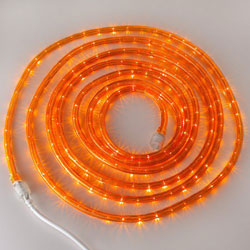
Head over to a hardware store or home improvement center and pick up a length of rope light. The shorter the better, because you're only going to need 18 inches of it or so. Make sure that the package notes that you can cut the rope light to length--this is important.
Read the package instructions for cutting the rope light. You may have to cut the light only at specific, marked spots; pick the spot that's closest to the 18- or 24-inch mark.
Make sure that the end of the rope light, as well as the connection between the rope and its power cord, is waterproof. Ideally, some large self-adhesive heatshrink tubing should be used, but not too many people have heatshrink tubing, let alone 1" diameter heatshrink tubing, laying around the house. In that case, use some of your leftover aquarium sealant in these places. Remember, water and electricity don't mix.
Once your short section of rope light is all ready to go, slip it through one of the ports on the back of the Mac case (the power socket hole works great) and either loop the light up along the back inside of the case, or run it up and around the edge of the top cutout. In either case, aquarium sealant should be sufficiently strong to keep the ropelight in place.
What color of ropelight you choose is up to you, but I'd strongly recommend you stick to plain white. It'll show off the color of your fish and also keep them from going wacky.
Tank Stuff
For both fishy survival as well as aesthetic reasons, you just can't pour a bunch of water into the tank, dump a fish in, and say you're done. You need to make the tank a home for your fish; fish need gravel, plants, and other stuff in order to survive and be comfortable. Here's a list of stuff you'll need to get a basic aquarium up and running.
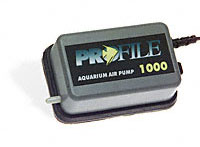
Air pump. Remember that fish breathe through oxygen dissolved in the water. Just as you wouldn't put your dog in a box with only a teeny hole for ventilation, a fishtank needs a little help in making sure that there's enough oxygen in the water for fishy survival. That's where an air pump comes into play. The smallest one you can find should suffice. It's going to have a small port where you plug in...
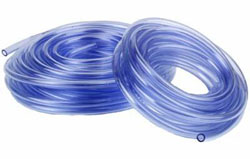 Air hose. This is what you use to get the air from your pump into the tank. Since air pumps are electrical, they need to stay outside the tank. Air hose comes in various diameters and lengths; get the size that's appropriate for your pump, and about 10 feet is usually more than enough. Air hose connects to various apparatuses in the tank, including air stones, water filters, bubblers and underwater toys. To split the output from the air pump to multiple devices in the tank, you need what is known as a gang valve.
Air hose. This is what you use to get the air from your pump into the tank. Since air pumps are electrical, they need to stay outside the tank. Air hose comes in various diameters and lengths; get the size that's appropriate for your pump, and about 10 feet is usually more than enough. Air hose connects to various apparatuses in the tank, including air stones, water filters, bubblers and underwater toys. To split the output from the air pump to multiple devices in the tank, you need what is known as a gang valve.
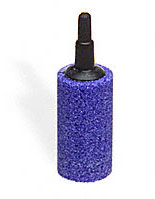 Air stone. This is a small, porous stone that's designed to disperse the air coming from your air pump into tiny bubbles that aerate the water, thus dissolving oxygen into it. The bubbles can also help circulate the water, which allows it to have a more even temperature and allows aquarium chemicals to disperse faster. Even if you decide to use a filter system (which usually releases bubbles), an air stone is a good idea. You can bury these under the gravel or hang them on the side of the tank.
Air stone. This is a small, porous stone that's designed to disperse the air coming from your air pump into tiny bubbles that aerate the water, thus dissolving oxygen into it. The bubbles can also help circulate the water, which allows it to have a more even temperature and allows aquarium chemicals to disperse faster. Even if you decide to use a filter system (which usually releases bubbles), an air stone is a good idea. You can bury these under the gravel or hang them on the side of the tank.
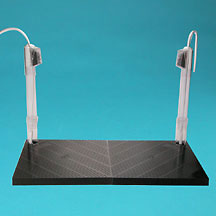 Water filter. Not an absolute necessity, but very convenient. These systems come in two varieties: one is a combination pump/filter unit that hangs on the side or back of the aquarium and filters water through it (often called biowheel or waterfall filters), and another is an undergravel type that, when connected to an air pump, passes the water through a filter. In both types, the filter uses activated charcoal to remove impurities and dirt (such as uneaten fish food and poop) from the water. Without a filter, expect to have to clean the tank at least once a week. With a filter, you'd only have to do it every two or three weeks. The filters are disposable and inexpensive. You may have some trouble finding an undergravel filter small enough to fit a MacQuarium, as most are designed for at least a 5-gallon tank. Shop around; small enough filters do exist. If you really can't find one, ask the pet store staff if they have any other ideas for filtration for your tank -- remember, it holds about 2.5 gallons.
Water filter. Not an absolute necessity, but very convenient. These systems come in two varieties: one is a combination pump/filter unit that hangs on the side or back of the aquarium and filters water through it (often called biowheel or waterfall filters), and another is an undergravel type that, when connected to an air pump, passes the water through a filter. In both types, the filter uses activated charcoal to remove impurities and dirt (such as uneaten fish food and poop) from the water. Without a filter, expect to have to clean the tank at least once a week. With a filter, you'd only have to do it every two or three weeks. The filters are disposable and inexpensive. You may have some trouble finding an undergravel filter small enough to fit a MacQuarium, as most are designed for at least a 5-gallon tank. Shop around; small enough filters do exist. If you really can't find one, ask the pet store staff if they have any other ideas for filtration for your tank -- remember, it holds about 2.5 gallons.
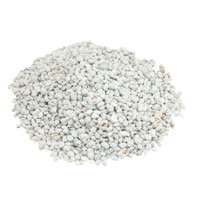 Gravel. Essential for fish. This simulates the lake or river floor that they're instinctively accustomed to, and allows for helpful bacteria and algae to grow. It comes in many colors, textures and sizes. Fish don't seem to care about the color so much, considering they're color-blind. About five pounds of gravel is all you'll need; conveniently, many pet stores package gravel in such increments.
Gravel. Essential for fish. This simulates the lake or river floor that they're instinctively accustomed to, and allows for helpful bacteria and algae to grow. It comes in many colors, textures and sizes. Fish don't seem to care about the color so much, considering they're color-blind. About five pounds of gravel is all you'll need; conveniently, many pet stores package gravel in such increments.
Be sure to wash your gravel out before putting it in the tank, as the milling process in the factory can leave it with a powder stuck to it.
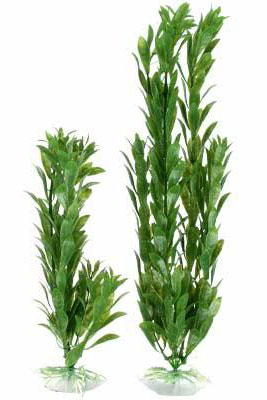 Plants. Fish like to have places to hide sometimes, and plants work well for them. If you're up to the challenge, you can buy real aquatic plants to put in your MacQuarium, but for most, they're more hassle than they're worth. Artificial plants work just fine and are usually made out of plastic or silk. You'll want at least one plant in your MacQuarium, but two is a good idea. You can plant one in front of your air stone or filter tube to hide it, and use the other as a hiding place for your fish. (Sometimes fish just want to be alone.)
Plants. Fish like to have places to hide sometimes, and plants work well for them. If you're up to the challenge, you can buy real aquatic plants to put in your MacQuarium, but for most, they're more hassle than they're worth. Artificial plants work just fine and are usually made out of plastic or silk. You'll want at least one plant in your MacQuarium, but two is a good idea. You can plant one in front of your air stone or filter tube to hide it, and use the other as a hiding place for your fish. (Sometimes fish just want to be alone.)
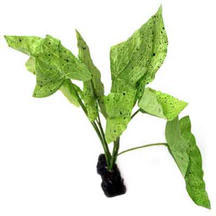 About eight inches is all the taller of plant you'll need, otherwise you'll have excess floating at the top. Most plants have weighted bottoms that you can bury under the gravel for stability and looks.
About eight inches is all the taller of plant you'll need, otherwise you'll have excess floating at the top. Most plants have weighted bottoms that you can bury under the gravel for stability and looks.
All told, this stuff should run you between $30 and $40 at the typical pet store. You'll likely need to replace the gravel and air stone after a couple years, and the filter cartridge will need to be swapped out periodically, but the rest should last the life of the tank.
Preparing for Fish
Once you've got all of your tank goodies put together, there's a couple more things you need to do yet before you can drop your fish in. Tank preparation is key, because an absurdly high percentage of fish die the same day they are brought home due to shock from an improperly prepared tank. We want to keep that from happening.
Pull the tank out of the MacQuarium while you fit the goodies in it. If you bought an undergravel filter, put it in the tank and position it in one of the back corners. Wash out your gravel thoroughly, and bury the filter base underneath it. Cut your air hose to length and attach it to the filter, air stone, and gang valve. Bury the base of your plants under the gravel. Slide the tank back into the MacQuarium shell, put the front bezel on, and put the thing where you plan to keep it. (The tank becomes quite heavy when filled with water, so you're going to want to fill it in place. Don't attempt to move it when it's full!)
Get your light and air pump set up, and then get three gallons of room-temperature tap water ready. Don't use softened water, as the salt content is too high for normal freshwater fish. Fill the tank with water until the waterline is just above the top of the screen cutout. Turn on the pump, but leave the light off for now.
Plain tap water is treated with chemicals like chlorine and fluorine. These are bad for fish, so we need to neutralize them before the fish can be put in. There are two products I recommend you buy only because I've used them for a long time and know they work.
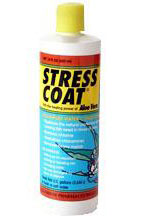 The first is Stress Coat by Aquarium Pharmaceuticals. It's a combination water treater and also helps fish keep the "slime coat" they usually have on their scales. The result is that the water is chemical-free and the fish stay healthier.
The first is Stress Coat by Aquarium Pharmaceuticals. It's a combination water treater and also helps fish keep the "slime coat" they usually have on their scales. The result is that the water is chemical-free and the fish stay healthier.
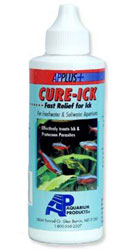 The second is Cure-Ick by Aquarium Products. Ick, known scientifically as Ichthyophthirius multifiliis, is a parasite that can kill fish. It appears as white crystals or strands, and attaches itself to fishes' scales. Ick can make it hard for fish to breathe and can also irritate them, causing them to rub against rocks and gravel. Even if you're sure your water doesn't have ick, get some of this stuff anyway; should it appear in your tank, it can only take a couple days to kill your fish. I always play it safe and put some in the tank every time I change the water.
The second is Cure-Ick by Aquarium Products. Ick, known scientifically as Ichthyophthirius multifiliis, is a parasite that can kill fish. It appears as white crystals or strands, and attaches itself to fishes' scales. Ick can make it hard for fish to breathe and can also irritate them, causing them to rub against rocks and gravel. Even if you're sure your water doesn't have ick, get some of this stuff anyway; should it appear in your tank, it can only take a couple days to kill your fish. I always play it safe and put some in the tank every time I change the water.
With both chemicals, follow the directions on the label to determine how much to put in. Remember that the MacQuarium tank holds approximately 2.5 gallons of water.
Once you have the chemicals in, let the water sit for at least 12 hours to stabilize and reach room temperature. Most fish are very sensitive to their surroundings, and changes in temperature, chemical composition, etc. can shock and kill them.
While you wait for the tank to stabilize, get two or three empty milk gallon jugs and fill them with water. Add the appropriate amount of chemicals to them, put the lids on the jugs, and store them someplace near the tank. This is the water you'll use when it comes time to clean the tank. Instead of leaving your poor fish in a small container of dirty water, you can pour in your already-conditioned and room-temperature water and get the fish back in the tank sooner (see the Care section for more information).
The Big Event
Once your tank is set up, conditioned, and you're sure it won't leak (now is the final time you can check without major inconvenience, namely, having a fish to deal with), head out and buy your fish.
In a previous version of this guide I suggested several good species of fish, and how many of each you can put in the tank. Long story short, I got a nastygram in my inbox one day from a goldfish's rights activist group (I'm not making this up), claiming that it's cruel to keep a goldfish in a 2.5-gallon tank, and demanding that I remove goldfish from the list of recommended fish. I eventually got them to back down, but in the process decided that I didn't want to deal with that kinda crap again, so I'm no longer making recommendations for which fish are best for a MacQuarium. (I had e-mailed several biologists and fish experts, but never got a decisive verdict on whether it's cruel to keep a goldfish in a 2.5-gallon tank.) Ultimately, it's up to you to seek advice from an ichthyologist or knowledgeable fish shop.
When you get your fish, you'll take it (or them) home in a plastic bag with an adequate amount of water and the rest of the bag inflated with air. This actually allows the bag to float, which is a good thing.
The water in the bag is most likely at a different temperature than the water in your MacQuarium. And since fish can be killed by sudden temperature changes, you need a way to gradually bring the water in the bag to the temperature of the water in the tank.
So all you need to do is float the bag with the fish in the MacQuarium for about half an hour. Set it in the cutout at the top, and when the half-hour is over, just cut the bag open and pour the contents, fish and all, into the MacQuarium.
Turn the light off for a while, because being moved can be enough of a stress for the fish. It doesn't hurt to sprinkle a little food in the tank, but don't expect the fish to gobble it up right away. Just let the fish become accustomed to the new surroundings and get settled.
Copyright 2009 Colin Wirth.
